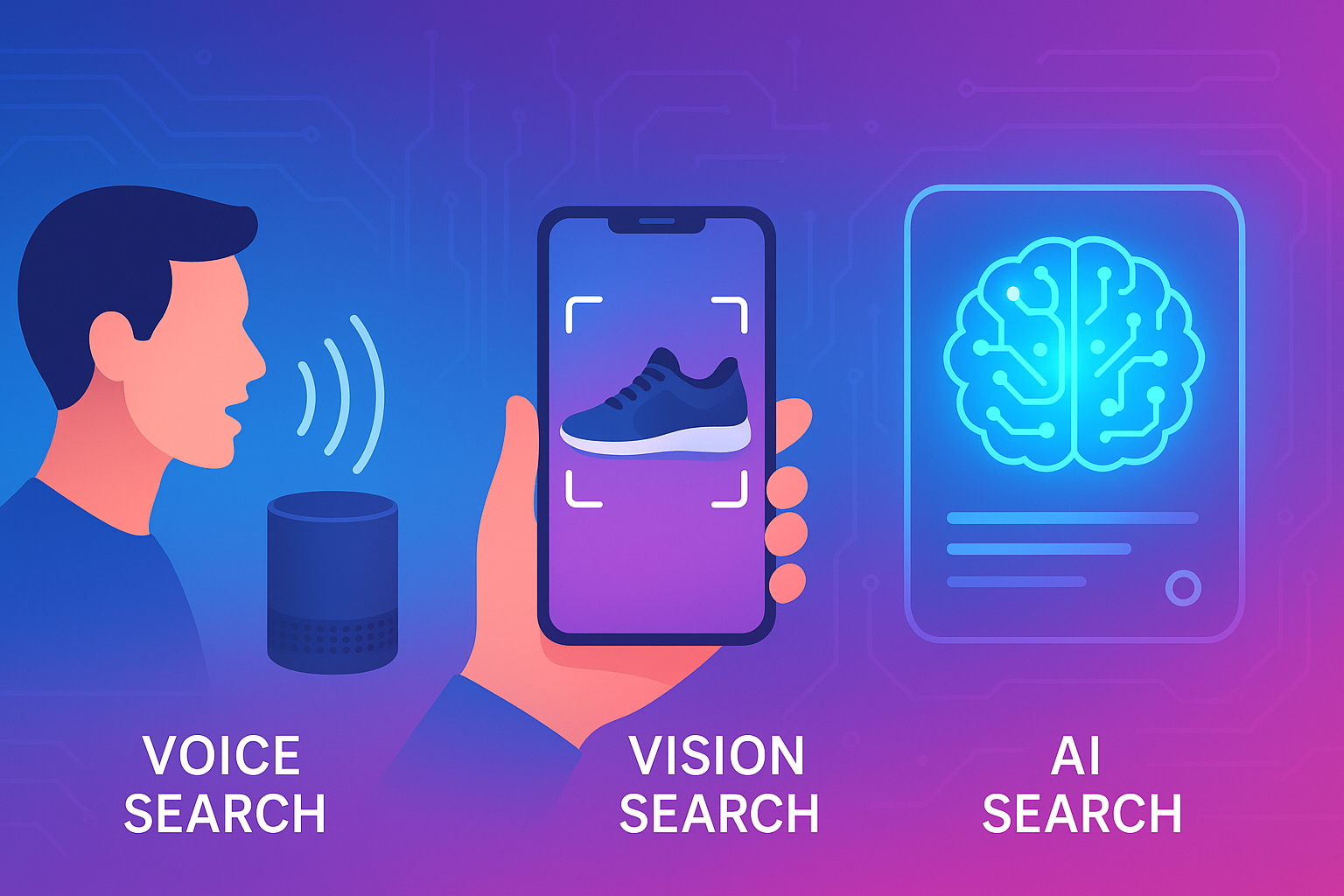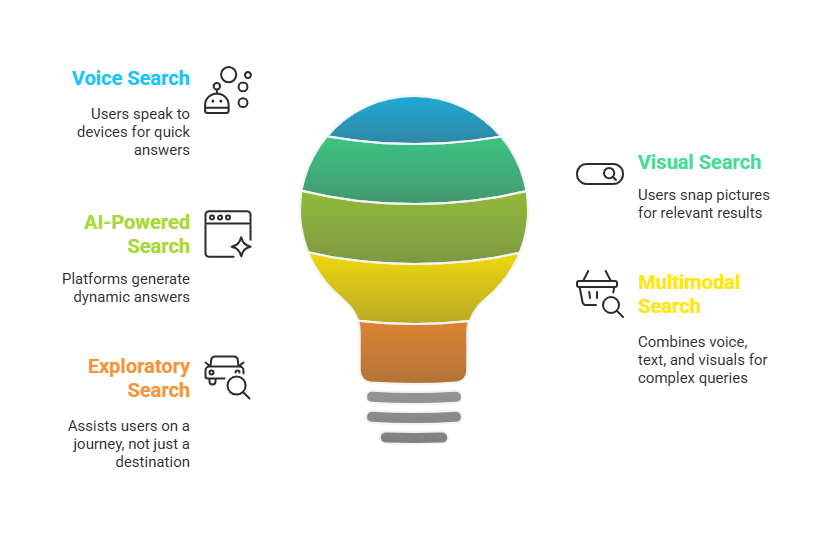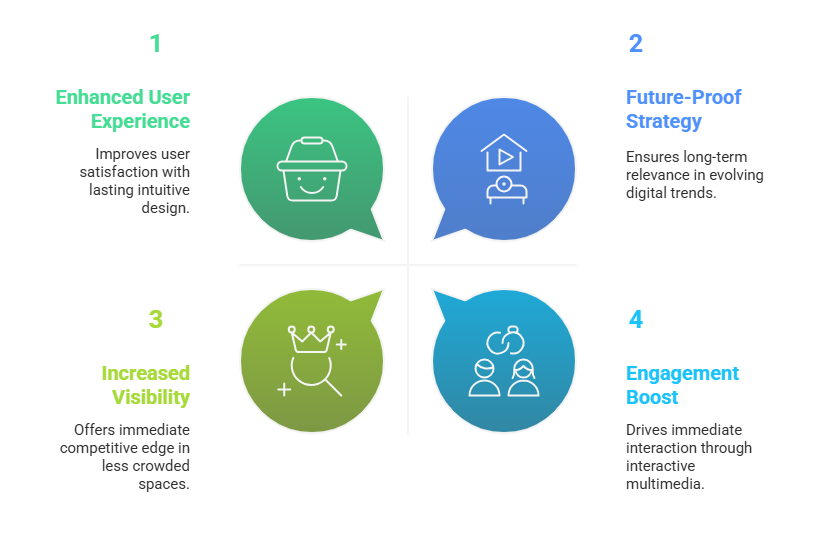
Search marketing is transforming at lightning speed. We no longer live in a world where keyword stuffing gets you clicks. Today’s digital consumers are speaking to smart devices, snapping photos to search, and using AI to answer their questions.
The future of SEO is multimodal. It’s powered by voice, vision, and AI. And if you’re a brand that wants to be found, you need to evolve with it. In this blog, we break down how search has moved beyond keywords and what it means for your marketing strategy.
There was a time when stuffing your page with keywords could win the SEO game. But today, that strategy is outdated. Search engines like Google are now smart enough to detect when content lacks value, context, or relevance. The rise of AI search and semantic algorithms means search is about understanding intent, not just matching words.
No longer is it enough to rank for “best running shoes.” Google wants to know why someone is searching for that phrase. Are they training for a marathon? Looking for budget-friendly options? Searching for a gift?
Search has moved from basic keyword matching to deep contextual understanding. AI tools now prioritize user experience, serving up AI-generated overviews and zero-click results that answer questions before a user even clicks a link.
This shift demands a new mindset from marketers: creating valuable, context-rich content that truly serves the user's purpose not just checks SEO boxes.
The landscape of search has exploded beyond traditional methods. Now, people aren’t just typing, they’re speaking, snapping, and even combining input modes to find what they’re looking for.
Let’s take a quick tour of the modern search playground:
Voice Search: Users ask, and devices like Alexa or Siri answer with speed and accuracy.
Visual Search: Snap a picture, and platforms like Google Lens or Pinterest return relevant results.
AI-Powered Search: Platforms generate dynamic answers based on massive data and personalized context.
Multimodal Search: Combine voice, text, and visuals to get results tailored to complex queries.
Exploratory Search: Think “I want to start a garden” rather than “best tomato seeds.” The search now assists you on a journey, not just a destination.
Each of these modalities demands a different approach and offers a unique opportunity for marketers to engage users where they are.

We’ve entered the era where talking to machines feels as natural as talking to a friend. Voice search enables users to speak their queries aloud whether it’s “What’s the weather like in Tokyo?” or “Find me a nearby vegan bakery.”
It works through Natural Language Processing (NLP), allowing smart assistants like Alexa, Google Assistant, or Siri to process voice, understand context, and deliver accurate results.
For users, this is fast, hands-free, and increasingly accurate. For businesses, it opens doors to new ways of being found especially for local and service-based queries.
To optimize for voice search, businesses need to think conversationally. This means focusing on long-tail keywords, question-based content, and local SEO. A voice search isn’t “best café NYC”—it’s “What’s the best café near me open right now?”
Want your brand to be the answer? Start sounding more human.
Why describe what you can show?
Visual search lets users upload an image and find relevant results, think Google Lens identifying a plant or Pinterest Lens showing where to buy a jacket from a photo.
It uses computer vision to analyze the image, compare it with massive databases, and serve up visually and contextually relevant content.
For users, it’s intuitive. For businesses, especially in fashion, home décor, food, and travel, it’s a game-changer. If your products are online but not image-optimized, you’re invisible in visual search.
To capitalize on this, brands should ensure high-quality images, detailed alt text, structured data, and even explore visual search tools like Pinterest’s Shopping Ads or Google’s Visual Product Feeds.
When users are searching with their eyes, make sure your visuals do the talking.
Forget the old blue links—AI-powered search is rewriting the search experience. Tools like ChatGPT, Google’s SGE (Search Generative Experience), and Perplexity AI generate responses that feel more like conversations and less like results pages.
These systems don’t just fetch results, they generate answers, summarize content, and offer nuanced responses using large datasets and trusted sources.
The impact? Users get more precise, personalized, and informative content often without ever leaving the search page.
For marketers, this changes the game. Your content must now feed the machine: well-structured, informative, trustworthy, and AI-friendly.
Want to rank in AI answers? Focus on EEAT (Experience, Expertise, Authority, Trust), answer questions clearly, and ensure your content is machine-readable with structured markup and schema.
Why settle for one input when you can use many?
Multimodal search blends text, voice, images, and even video into a single query experience. Imagine asking, “What are the best shoes for this outfit?” while uploading a picture of your dress. That’s multimodal in action.
AI like GPT-4o or Gemini now processes multiple modes simultaneously, understanding complex intent from diverse input.
For users, this means smoother, more flexible experiences. For businesses, it means multi-format optimization not just good text, but clear visuals, spoken intent, and rich metadata.
Want to win at multimodal? Ensure your content is accessible and optimized across formats, devices, and contexts. Think captioned videos, voice-friendly scripts, and visual tagging.
These modern search methods aren’t just cool tech they deliver measurable value.
Enhanced User Experience: More intuitive, faster, and tailored to how people actually search.
Increased Visibility: Voice and visual platforms are less crowded—offering a first-mover advantage.
Engagement Boost: AI and multimedia search create more engaging, interactive experiences.
Future-Proof Strategy: Adapt now and stay ahead of shifting digital marketing trends.
And yes, this shift is already happening. The question is: Will your brand be part of the future of SEO services?

Search today is about intent, not just input.
Under it all? Machine learning. AI. Behavioral data. And a need to understand the user’s journey, not just the query.
Here’s how brands can stand out in each search mode:
Voice Search: Write conversational content. Use FAQ pages. Optimize for local and mobile.
Visual Search: Upload high-res images. Add alt text and structured data. Be on Pinterest and Google Shopping.
AI-Powered Search: Prioritize trust, structure, and value. Use schema markup. Write content with clear answers.
Multimodal Search: Think holistically. Your visuals, voice, and text must tell a consistent story.
If you're not thinking across modes, you're not thinking ahead.
To play the new game, you need the right tools.
Personalization isn’t a bonus, it’s expected.
User Benefits: Faster answers, more relevance, better satisfaction.
Marketing Impact: Hyper-targeted visibility, higher ROI, smarter segmentation.
What Marketers Must Do: Collect insights, understand user behavior, and build content marketing plans around personas—not just search volumes
The world of search marketing has moved far beyond keywords. As voice, visual, AI-powered, and multimodal search continue to evolve, they’re not just changing how people find information, they’re redefining how brands are discovered. From understanding user intent through spoken queries to identifying products with a single image, the modern search experience demands a new level of adaptability, creativity, and intelligence from marketers.
To stay ahead, businesses must evolve with these trends. It’s not about chasing algorithms anymore, it’s about creating meaningful, optimized content that speaks across formats and platforms. Whether it’s through conversational content, image optimization, or leveraging AI to understand audience needs, the future belongs to brands that embrace this change.
At DigiTaliya, we help future-focused brands thrive in this new search era. From cutting-edge SEO services to strategic social media marketing and immersive content marketing, we build strategies that position you at the forefront of discovery.
Because when the way people search changes, so should the way you show up. Let’s build your brand for the search of tomorrow.